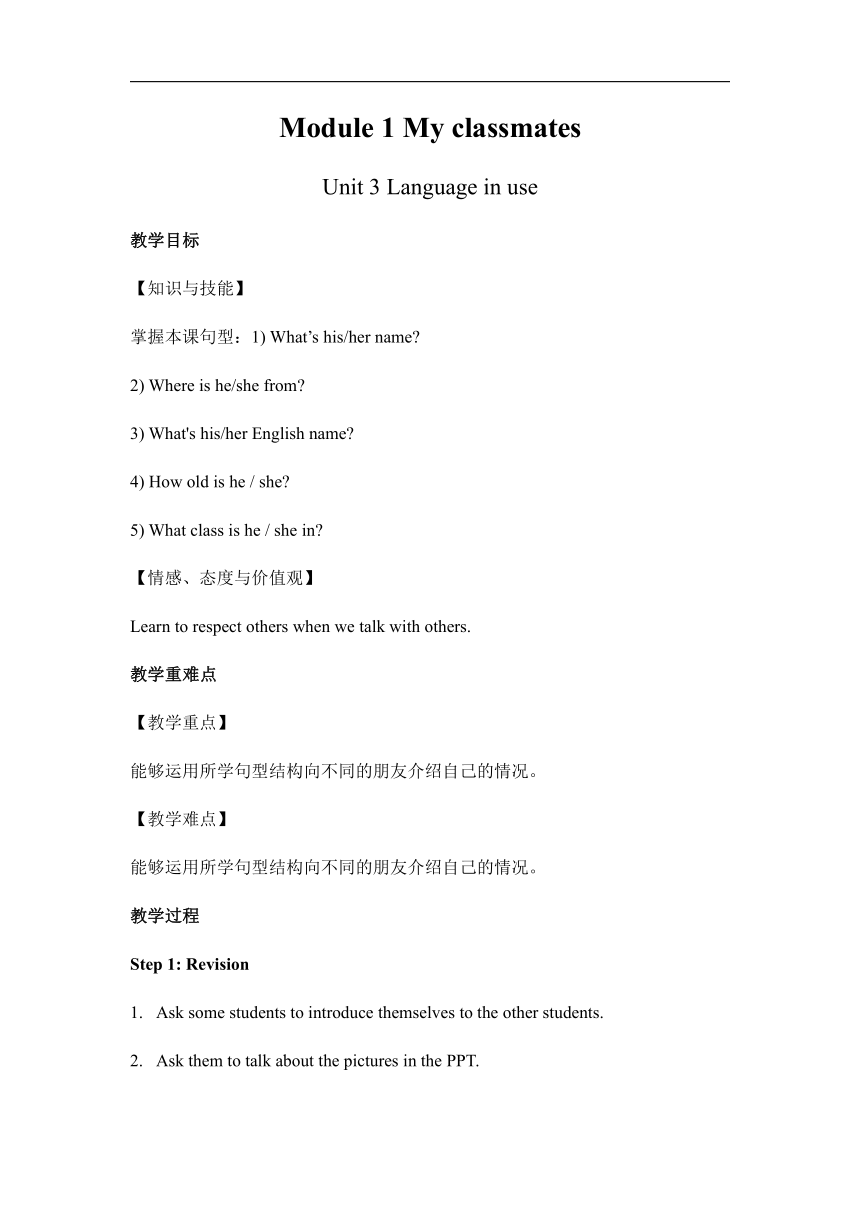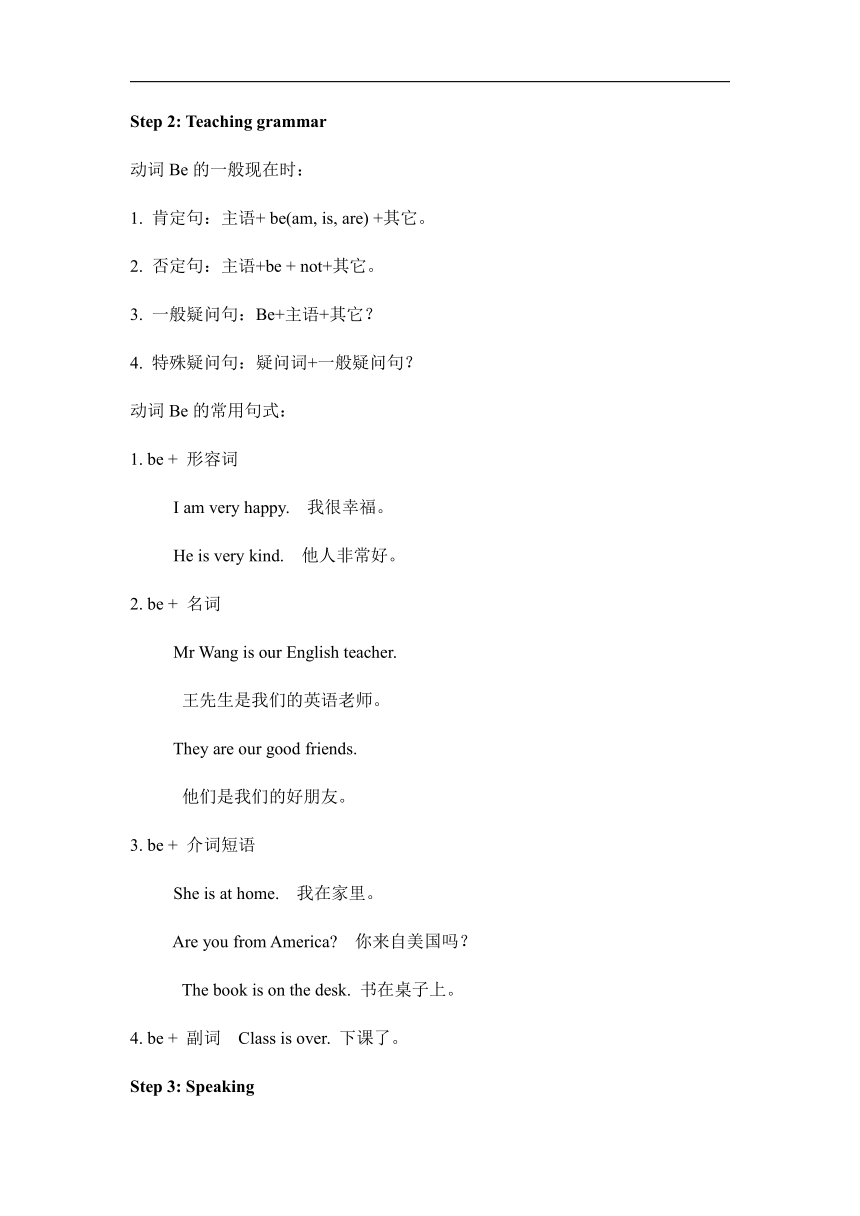Module 1 My classmates Unit 3 Language in use 教案
文档属性
| 名称 | Module 1 My classmates Unit 3 Language in use 教案 |

|
|
| 格式 | docx | ||
| 文件大小 | 141.0KB | ||
| 资源类型 | 教案 | ||
| 版本资源 | 外研版 | ||
| 科目 | 英语 | ||
| 更新时间 | 2020-08-03 19:47:51 | ||
图片预览


文档简介
Module 1 My classmates
Unit 3 Language in use
教学目标
【知识与技能】
掌握本课句型:1) What’s his/her name?
2) Where is he/she from?
3) What's his/her English name?
4) How old is he / she?
5) What class is he / she in?
【情感、态度与价值观】
Learn to respect others when we talk with others.
教学重难点
【教学重点】
能够运用所学句型结构向不同的朋友介绍自己的情况。
【教学难点】
能够运用所学句型结构向不同的朋友介绍自己的情况。
教学过程
Step 1: Revision
Ask some students to introduce themselves to the other students.
Ask them to talk about the pictures in the PPT.
Step 2: Teaching grammar
动词Be的一般现在时:
1. 肯定句:主语+ be(am, is, are) +其它。
2. 否定句:主语+be + not+其它。
3. 一般疑问句:Be+主语+其它?
4. 特殊疑问句:疑问词+一般疑问句?
动词Be的常用句式:
1. be + 形容词
I am very happy. 我很幸福。
He is very kind. 他人非常好。
2. be + 名词
Mr Wang is our English teacher.
王先生是我们的英语老师。
They are our good friends.
他们是我们的好朋友。
3. be + 介词短语
She is at home. 我在家里。
Are you from America? 你来自美国吗?
The book is on the desk. 书在桌子上。
4. be + 副词 Class is over. 下课了。
Step 3: Speaking
Ask the students to introduce the three people in act 1.
You can do it like this:
This is Sam.
He is twelve.
He's from England.
He's in Class 1.
Step 4: Practise
Do act 2-4 by themselves and check the answers in groups.
Ask one group the report their answers.
Step 5: Around the word
1. Tell students the difference between Chinese names and English names.
T: Most English people have three names: a first name, a middle name and the family name. The first name and the middle name are given names. Their family name comes last. For example, Jim Allan Green. Green is family name. Chinese names are different. Now read and find the difference in Around the world.
Step 6: Module task
Look at the screen. Introduce yourself. Ask and answer with a partner. Then report their result in front of the whole class.
Step 7: Do exercises
Do the exercises in the PPT. The teacher checks the answers.
Step 8: Sum up
Ask the students to talk about “What have you learned in this lesson?”.
Sum up the different ways of “Be” and report it.
Homework
查找资料名人资料,向全班同学介绍你心目中最喜爱的明星或最尊敬的人。
教学反思
Unit 3 Language in use
教学目标
【知识与技能】
掌握本课句型:1) What’s his/her name?
2) Where is he/she from?
3) What's his/her English name?
4) How old is he / she?
5) What class is he / she in?
【情感、态度与价值观】
Learn to respect others when we talk with others.
教学重难点
【教学重点】
能够运用所学句型结构向不同的朋友介绍自己的情况。
【教学难点】
能够运用所学句型结构向不同的朋友介绍自己的情况。
教学过程
Step 1: Revision
Ask some students to introduce themselves to the other students.
Ask them to talk about the pictures in the PPT.
Step 2: Teaching grammar
动词Be的一般现在时:
1. 肯定句:主语+ be(am, is, are) +其它。
2. 否定句:主语+be + not+其它。
3. 一般疑问句:Be+主语+其它?
4. 特殊疑问句:疑问词+一般疑问句?
动词Be的常用句式:
1. be + 形容词
I am very happy. 我很幸福。
He is very kind. 他人非常好。
2. be + 名词
Mr Wang is our English teacher.
王先生是我们的英语老师。
They are our good friends.
他们是我们的好朋友。
3. be + 介词短语
She is at home. 我在家里。
Are you from America? 你来自美国吗?
The book is on the desk. 书在桌子上。
4. be + 副词 Class is over. 下课了。
Step 3: Speaking
Ask the students to introduce the three people in act 1.
You can do it like this:
This is Sam.
He is twelve.
He's from England.
He's in Class 1.
Step 4: Practise
Do act 2-4 by themselves and check the answers in groups.
Ask one group the report their answers.
Step 5: Around the word
1. Tell students the difference between Chinese names and English names.
T: Most English people have three names: a first name, a middle name and the family name. The first name and the middle name are given names. Their family name comes last. For example, Jim Allan Green. Green is family name. Chinese names are different. Now read and find the difference in Around the world.
Step 6: Module task
Look at the screen. Introduce yourself. Ask and answer with a partner. Then report their result in front of the whole class.
Step 7: Do exercises
Do the exercises in the PPT. The teacher checks the answers.
Step 8: Sum up
Ask the students to talk about “What have you learned in this lesson?”.
Sum up the different ways of “Be” and report it.
Homework
查找资料名人资料,向全班同学介绍你心目中最喜爱的明星或最尊敬的人。
教学反思
同课章节目录
- Starte
- Module 1 My teacher and my friends
- Module 2 My English lesson
- Module 3 My English book
- Module 4 My everyday life
- Module 1 My classmates
- Unit 1 Nice to meet you.
- Unit 2 I'm Wang Lingling and I'm thirteen years ol
- Unit 3 Language in use.
- Module 2 My family
- Unit 1 Is this your mum?
- Unit 2 These are my parents.
- Unit 3 Language in use.
- Module 3 My school
- Unit 1 There are thirty students in my class.
- Unit 2 The library is on the left of the playgroun
- Unit 3 Language in use.
- Module 4 Healthy food
- Unit 1 We've got lots of apples.
- Unit 2 Is your food and drink healthy?
- Unit 3 Language in use.
- Module 5 My school day
- Unit 1 I love history.
- Unit 2 We start work at nine o'clock.
- Unit 3 Language in use.
- Revision module A
- Module 6 A trip to the zoo
- Unit 1 Does it eat meat?
- Unit 2 The tiger lives in Asia.
- Unit 3 Language in use.
- Module 7 Computers
- Unit 1 How do I write my homework on the computer?
- Unit 2 When do you use a computer?
- Unit 3 Language in use.
- Module 8 Choosing presents
- Unit 1 I always like birthday parties.
- Unit 2 She often goes to concerts.
- Unit 3 Language in use.
- Module 9 People and places
- Unit 1 We're enjoying the school trip a lot.
- Unit 2 They're waiting for buses or trains.
- Unit 3 Language in use.
- Module 10 Spring Festival
- Unit 1 Are you getting ready for Spring Festival?
- Unit 2 My mother's cleaning our houses and sweepin
- Unit 3 Language in use.
- Revision module B
